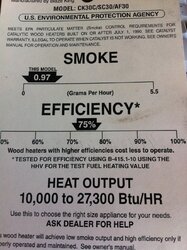As usual, I'm confused by the output numbers on some of these big stoves. EPA rates the Cape Cod well below the Manchester and the Isle Royale, and of course manufacturer claims are totally different. 
They are all pretty much the same size so I have to believe the outputs are going to be similar. The IR is the most radiant of the three, clearly.
Might be a while before someone runs all three and can report back.

They are all pretty much the same size so I have to believe the outputs are going to be similar. The IR is the most radiant of the three, clearly.
Might be a while before someone runs all three and can report back.



